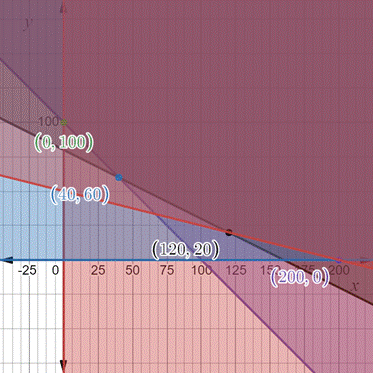
To calculate: The minimize cost to place the order by customer.
40 operations at Refinery 1, 60 at Refinery 2, $48000, or 120 operations at Refinery 1, 20 at Refinery 2, $48000.
Given Information:
Two oil refineries produce three grades of gasoline: A, B, and C. At each refinery, the three grades of gasoline are produced in a single operation in the following proportions: Refinery 1 produces 1 unit of A, 2 units of B, and 1 unit of C; Refinery 2 produces 1 unit of A, 4 units of B, and 4 units of C. For the production of one operation, Refinery 1 charges $300 and Refinery 2 charges $600. A customer needs 100 units of A, 320 units of B. and 200 units of C.
Calculation:
Consider the given information,
Suppose that x the number of operations produced at Refinery 1 and y the number of operations produced at Refinery 2.
Write the constraints as a system of inequalities using the given information.
Write the objective function by using the given information.
Use the graphing calculator to draw the inequality and find the corner points.

The corner points are
Now, find the value of the objective function on corner points.
Substitute 0 for x and 100 for y in the objective function.
Substitute 40 for x and 60 for y in the objective function.
Substitute 200 for x and 0 for y in the objective function.
Substitute 120 for x and 20 for y in the objective function.
The cost is minimized by producing 40 operations at Refinery 1 and 60 at Refinery 2, and by producing 120 operations at Refinery 1 and 20 at Refinery 2 and the both cost is $48000.
As the feasible region is unbounded and has
Therefore, 40 operations at Refinery 1, 60 at Refinery 2, $48000, or 120 operations at Refinery 1, 20 at Refinery 2, $48000, If conservation of operations is favoured, the first option would be the best choice..
/EXPLANATION>-->
Chapter 7 Solutions
PRECALCULUS:GRAPH...-NASTA ED.(FLORIDA)
- please question 9arrow_forwardUse the definite integral to find the area between the x-axis and f(x) over the indicated interval. Check first to see if the graph crosses the x-axis in the given interval. 3. f(x) = 4x; [-5,3]arrow_forwardUse the definite integral to find the area between the x-axis and f(x) over the indicated interval. Check first to see if the graph crosses the x-axis in the given interval. f(x)=3e-4; [3,3]arrow_forward
- A small company of science writers found that its rate of profit (in thousands of dollars) after t years of operation is given by P'(t) = (7t + 14) (t² + 4t+7) * (a) Find the total profit in the first four years. (b) Find the profit in the sixth year of operation. (c) What is happening to the annual profit over the long run?arrow_forwardCalculus III May I have an expert explained how the terms were simplified into 6(3-x)^2? Thank you,arrow_forwardCalculus III May I have an expert explain how the integrand was simplified into the final for form to be integrated with respect to x? Thank you,arrow_forward
- Calculus lll May I please have the semicolon statement in the box defined with explanation? Thank you,arrow_forwardCalculus lll May I please have the solutions for the following blank lines? Thank you,arrow_forwardCalculus lll May I please have the solution for the following example? Thank you,arrow_forward
- Calculus lll May I please have numbers 1 and 2 explanations resolved? Thank you,arrow_forward5:38 Video Message instructor Submit Question ||| Darrow_forward8:38 *** TEMU TEMU -3 -2 7 B 2 1 & 5G. 61% 1 2 -1 Based on the graph above, determine the amplitude, period, midline, and equation of the function. Use f(x) as the output. Amplitude: 2 Period: 2 Midline: 2 ☑ syntax error: this is not an equation. Function: f(x) = −2 cos(πx + 2.5π) +2× Question Help: Worked Example 1 ☑ Message instructor Submit Question ||| <arrow_forward
 Calculus: Early TranscendentalsCalculusISBN:9781285741550Author:James StewartPublisher:Cengage Learning
Calculus: Early TranscendentalsCalculusISBN:9781285741550Author:James StewartPublisher:Cengage Learning Thomas' Calculus (14th Edition)CalculusISBN:9780134438986Author:Joel R. Hass, Christopher E. Heil, Maurice D. WeirPublisher:PEARSON
Thomas' Calculus (14th Edition)CalculusISBN:9780134438986Author:Joel R. Hass, Christopher E. Heil, Maurice D. WeirPublisher:PEARSON Calculus: Early Transcendentals (3rd Edition)CalculusISBN:9780134763644Author:William L. Briggs, Lyle Cochran, Bernard Gillett, Eric SchulzPublisher:PEARSON
Calculus: Early Transcendentals (3rd Edition)CalculusISBN:9780134763644Author:William L. Briggs, Lyle Cochran, Bernard Gillett, Eric SchulzPublisher:PEARSON Calculus: Early TranscendentalsCalculusISBN:9781319050740Author:Jon Rogawski, Colin Adams, Robert FranzosaPublisher:W. H. Freeman
Calculus: Early TranscendentalsCalculusISBN:9781319050740Author:Jon Rogawski, Colin Adams, Robert FranzosaPublisher:W. H. Freeman
 Calculus: Early Transcendental FunctionsCalculusISBN:9781337552516Author:Ron Larson, Bruce H. EdwardsPublisher:Cengage Learning
Calculus: Early Transcendental FunctionsCalculusISBN:9781337552516Author:Ron Larson, Bruce H. EdwardsPublisher:Cengage Learning





